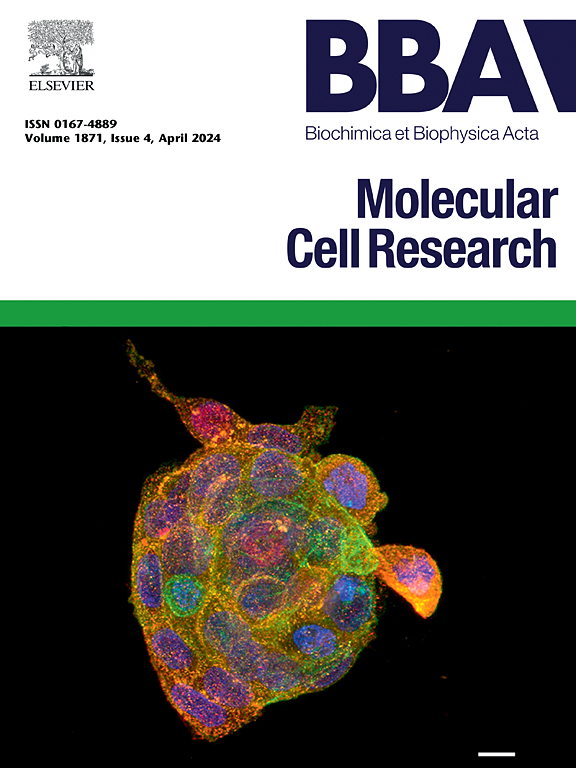USP15 promotes brain cell disulfidptosis in mouse subjected to ischemic stroke through a mechanism involving deubiquitination of SETD1B
IF 4.6
2区 生物学
Q1 BIOCHEMISTRY & MOLECULAR BIOLOGY
Biochimica et biophysica acta. Molecular cell research
Pub Date : 2025-07-01
DOI:10.1016/j.bbamcr.2025.120016
引用次数: 0
Abstract
Disulfidptosis due to excessive accumulation of disulfides is a novel form of regulated cell death. Whether disulfidptosis occurs in ischemic stroke and the underlying mechanisms remain elusive. RNA transcriptomics sequencing (RNA-seq) reveales that knockdown of SET domain containing 1B (SETD1B), a histone lysine methyltransferase, decreases the expression of disulfidptosis-related genes. Using Ubibrowser database, Ubiquitin-specific protease 15 (USP15) is predicted to be a deubiquitinase (DUB) for SETD1B. This study investigates whether SETD1B promote disulfidptosis in ischemic stroke via upregulating disulfidptosis-related genes and whether USP15 deubiquitinates SETD1B. A C57BL/6 J mouse model of ischemic stroke was established, which results in brain injury and upregulation of USP15 and SETD1B, concomitant with the increased disulfidptosis, as indicated by the increased level of NADP+/NADPH ratio, elevated protein levels of NCK associated protein 1 like (NCKAP1L) and WASP family protein member 2 (WAVE-2), disulfide bond accumulation, and cytoskeleton detachment from the cytoplasmic membrane. Similar results were observed in cultured HT22 cells subjected to oxygen-glucose deprivation plus reoxygenation (OGD/R), and USP15 or SETD1B siRNAs reversed these phenomena. Mechanistically, knockdown of SETD1B prevented H3K4me3 enrichment at the Nckap1l and Wasf2 promoters and reduced Nckap1l and Wasf2 expression. Moreover, knockdown of USP15 increased the ubiquitination level of SETD1B thus decreasing its protein level. Based on these findings, we concluded that SETD1B can promote disulfidptosis in stroke brain cells via a mechanism involving facilitating H3K4me3 enrichment at the Nckap1l and Wasf2 promoters, while USP15 is able to deubiquitinate SETD1B and increase SETD1B level in ischemic stroke mice.
USP15通过与SETD1B去泛素化有关的机制促进缺血性中风小鼠的脑细胞二亢
由于过量积累的二硫化物导致的二硫下垂是一种新的细胞死亡形式。缺血性脑卒中是否发生双睑下垂及其潜在机制尚不清楚。RNA转录组学测序(RNA-seq)显示,组蛋白赖氨酸甲基转移酶(SET)结构域1B (SETD1B)的敲低可降低二硫分解相关基因的表达。利用Ubibrowser数据库,我们预测泛素特异性蛋白酶15 (USP15)是SETD1B的去泛素酶(DUB)。本研究探讨SETD1B是否通过上调二硫塌陷相关基因促进缺血性卒中的二硫塌陷,以及USP15是否去泛素化SETD1B。建立C57BL/ 6j小鼠缺血性卒中模型,脑损伤,USP15和SETD1B水平上调,伴有二硫质下沉增加,表现为NADP+/NADPH比水平升高,NCK相关蛋白1样蛋白(NCKAP1L)和WASP家族蛋白成员2(波浪-2)蛋白水平升高,二硫键积累,细胞骨架脱离细胞质膜。在氧-葡萄糖剥夺加再氧化(OGD/R)的HT22细胞中也观察到类似的结果,USP15或SETD1B sirna逆转了这些现象。从机制上讲,敲低SETD1B可阻止H3K4me3在Nckap1l和Wasf2启动子上的富集,降低Nckap1l和Wasf2的表达。此外,USP15的敲除增加了SETD1B的泛素化水平,从而降低了其蛋白水平。基于这些发现,我们得出结论,SETD1B可以通过促进Nckap1l和Wasf2启动子上H3K4me3富集的机制促进脑卒中细胞的二硫醇凋亡,而USP15可以使缺血性脑卒中小鼠的SETD1B去泛素化并增加SETD1B水平。
本文章由计算机程序翻译,如有差异,请以英文原文为准。
求助全文
约1分钟内获得全文
求助全文
来源期刊
CiteScore
10.00
自引率
2.00%
发文量
151
审稿时长
44 days
期刊介绍:
BBA Molecular Cell Research focuses on understanding the mechanisms of cellular processes at the molecular level. These include aspects of cellular signaling, signal transduction, cell cycle, apoptosis, intracellular trafficking, secretory and endocytic pathways, biogenesis of cell organelles, cytoskeletal structures, cellular interactions, cell/tissue differentiation and cellular enzymology. Also included are studies at the interface between Cell Biology and Biophysics which apply for example novel imaging methods for characterizing cellular processes.

 求助内容:
求助内容: 应助结果提醒方式:
应助结果提醒方式:


